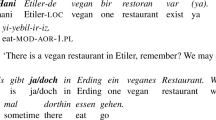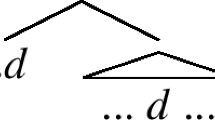Abstract
Minimizers are widely acknowledged cross-linguistically to denote a minimal quantity, extent or degree. With respect to minimizers in Mandarin Chinese, Shyu (Linguistics 54:1355–1395, 2016) claims that their so-called negative polarity is purely syntactically determined and is facilitated by the lian…dou (‘including…all’) EVEN construction. Within the framework of Dynamic Syntax (Kempson et al., Dynamic syntax: the flow of language understanding, Blackwell, 2001; Cann et al., The dynamics of language, Elsevier, 2005) which allows for interaction between syntactic, semantic and pragmatic information, we demonstrate that the total negation is actually derived from the interaction between syntax, semantics and pragmatics, rather than being determined by purely syntactic means.









Similar content being viewed by others
Notes
Abbreviations used in this paper are: CL: classifier; DOU: Chinese domain morpheme dou; GUO: experience aspect marker; LE: perfective aspect marker; LIAN: Chinese focus marker lian.
BCC, a corpus founded by Beijing Language and Culture University, includes nearly 15 billion Chinese characters, which ranges from newspapers, literatures to technologies. The corpus of CCL, (Center for Chinese Linguistics) is founded by Peking University.
One-phrases can also be separated by a modifier, such as yidun re fan ‘one hot meal’, yikou re shui ‘one hot water’, yiju kaopude hua ‘one serious word’ and so on.
In DS, proper names such as Lisi are treated as projecting an iota term (for detailed discussion, see Cann et al. 2005).
In Kempson et al. (2001: 110), LINK relations are defined “A Linked Basic Tree structure \(LBTR {\mathcal{T}}\) is a finite set of partial trees \({\mathcal{T}}_{1} \ldots , {\mathcal{T}}_{n}\)” with disjoint Tree Domains and a Link relation \(\prec L \subseteq {\text{U}}_{1 \le i \le n} TrDom_{i} \times {\text{U}}_{1 \le i \le n} TrDom_{i}\) such that, if \(n \prec {}_{L}^{{}} n^{\prime}\) holds between \(n \in TrDom_{i} , n^{\prime} \in TrDom_{j} , \) then \(i \ne j\).”.
We are grateful to one of the reviewers for pointing out this possibility to us.
References
Bolinger, D. (1972). Degree words. Mouton.
Cann, R., Kempson, R., & Marten, L. (2005). The dynamics of language. Elsevier.
Cann, R., Kempson, R., & Purver, M. (2007). Context and well-formedness: The dynamics of ellipsis. Research on Language and Computation, 5, 333–358.
Chao, Y.-R. (1968). A Grammar of Spoken Chinese. University of California Press.
Giannakidou, A. (1998). Polarity sensitivity as (non)veridical dependency. Benjamins.
Giannakidou, A. (2011). Negative and positive polarity items. In C. Maienborn, K. von Heusinger, & P. Portner (Eds.), Semantics: An international handbook of natural language meaning (pp. 1660–1712). Mouton de Gruyter.
Gregoromichelaki, E. (2006). Conditionals: A Dynamic Syntax account. London: King’s College London. Ph.D. Thesis.
Haspelmath, M. (1997). Indefinite pronouns. Oxford University Press.
Heim, I. R. (1984). A note on negative polarity and downward entailingness. Proceedings of NELS, 14, 98–107.
Hilbert, D., & Bernays, P. (1939). Grundlagen der Mathematik II. Springer.
Hole, D. (2004). Focus and Background Marking in Mandarin Chinese: System and Theory Behind cai, jiu, dou and ye. Routledge.
Horn, L. R. (1989). A natural history of negation. The University of Chicago Press.
Horn, L. R. (2001). A natural history of negation. CSLI Publications.
Horn, L. R., & Kato, Y. (2000). Introduction: Negation and polarity at the millennium. In L. R. Horn & Y. Kato (Eds.), Negation and polarity (pp. 1–19). Oxford University Press.
Israel, M. (2001). Minimizers, maximizers and the rhetoric of scalar reasoning. Journal of Semantics, 18, 297–331.
Israel, M. (2011). The grammar of polarity: Pragmatics, sensitivity, and the logic of scales. Cambridge University Press.
Kiss, K. É. (Ed.). (2002). The syntax of Hungarian. Cambridge University Press.
Klima, E. (1964). Negation in English. In J. A. Fodor & J. J. Katz (Eds.), The structure of language: Readings in the philosophy of language (pp. 246–323). Prentice Hall.
Kempson, R., Meyer-Viol, W., & Gabbay, D. (2001). Dynamic Syntax: The flow of language understanding. Blackwell.
Kempson, R., Cann, R., Eshghi, A., Gregoromichelaki, E., & Purver, M. (2015). Ellipsis. In S. Lappin & C. Fox (Eds.), Handbook of contemporary semantic theory (pp. 114–40). Wiley-Blackwell.
Lahiri, U. (1998). Focus and negative polarity in Hindi. Natural Language Semantics, 6, 23–57.
Laka, M. I. (1990). Negation in syntax: On the nature of functional categories and projections. Cambridge, MA: Massachusetts Institute of Technology dissertation.
Liu, D., & Xu, L. (1998). Jiaodian yu beijing, huati ji Hanyu lian zi ju [Focus and background, Topic and Chinese lian- sentences]. Zhongguo Yuwen, 4, 243–252. (studies of the Chinese Language).
Lü, S. X. (Ed.). (1980). Xiandai Hanyu Babaici. The Commercial Press. (Eight Hundred Words in Modern Chinese).
Nakanishi, K. (2006). Even, only, and negative polarity in Japanese. In M. Gibson & J. Howell (Eds.), SALT XVI (pp. 138–155). Cornell University.
Rooth, M. (1985). Association with focus. Lowell, MA: University of Massachusetts dissertation Rooth, M. (1996).
Shyu, S. (1995). The syntax of focus and topic in Mandarin Chinese. Los Angeles: University of Southern California dissertation
Shyu, S. (2004). (A)Symmetries between Mandarin Chinese lian…dou and shenzhi. Journal of Chinese Linguistics, 32, 81–128.
Shyu, S. (2016). Minimizers and EVEN. Linguistics, 54(6), 1355–1395.
Wang, C., & Su, L. I. (2012). Distinguishing synonymous constructions: A corpus based study of Mandarin lian…dou and lian…ye constructions. Journal of Chinese Linguistics, 40, 84–101.
Wang, L. (1954). Zhongguo Xiandai Yufa. Zhonghua Book Company. (Modern Grammar of Chinese).
Wu, Y. (2017). The interfaces of Chinese syntax with semantics and pragmatics. Routledge.
Yang, X., & Wu, Y. (2019). A dynamic account of lian…dou in Chinese verb doubling cleft construction. Lingua, 217, 24–44.
Zhu, D. (1982). Yufa Jiangyi. The Commercial Press. (Lectures on Chinese Grammar).
Funding
Funding was provided by Philosophy and Social Science Foundation of Zhejiang Province (Grant Number 19NDJC152YB) and Humanities and Social Sciences Research Project of the Ministry of Education,China (Grant Number 19YJCZH218).
Author information
Authors and Affiliations
Corresponding author
Additional information
Publisher's Note
Springer Nature remains neutral with regard to jurisdictional claims in published maps and institutional affiliations.
Rights and permissions
About this article
Cite this article
Yang, X., Wu, Y. A Dynamic Analysis of Minimizers in Chinese lian…dou Construction. J of Log Lang and Inf 30, 429–449 (2021). https://doi.org/10.1007/s10849-021-09335-w
Accepted:
Published:
Issue Date:
DOI: https://doi.org/10.1007/s10849-021-09335-w




